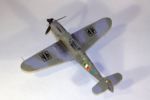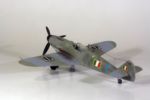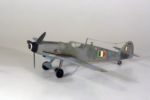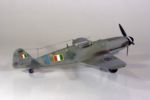(ita/eng)
ANR – Aeronautica Nazionale Repubblicana
Dal 1943 al 1945 la Repubblica Sociale Italiana ebbe la sua Aeronautica. Oltre 75.000 uomini, la maggior parte dei quali impiegata nelle batterie contraeree che si opponevano, assieme alla FLAK tedesca, ai bombardamenti anglo-americani sulle nostre città e le nostre fabbriche.
Furono organizzati anche reparti di volo, dapprima con caccia italiani FIAT G-55 e Macchi 205 e successivamente, per rimpiazzare le perdite, Messerschmitt 109 G-6, -10 e -14.
Un compito importante della nostra caccia era di intercettare all’andata le grosse formazioni di bombardieri alleati, obbligando i caccia di scorta (P-38, P-47, P-51 e Spitfire IX) a liberarsi dei serbatoi supplementari di carburante per recuperare velocità ed agilità. Si riduceva così la loro autonomia, rendendo di fatto impossibile proseguire il volo fino agli stabilimenti nel cuore della Germania. I bombardieri dovevano perciò raggiungere i loro bersagli senza i caccia di scorta…
Il modello qui rappresentato è un Messerschmitt Bf 109 G-14/R1, riconoscibile dai due rigonfiamenti sul muso. Questi rigonfiamenti ospitavano il grosso otturatore delle mitragliatrici MG 131 da 13 mm.
La mimetizzazione è quella tipica della Luftwaffe. Sono stati dipinti i fasci repubblicani sul lato superiore delle ali e la bandiera tricolore sulla fusoliera e sul timone. Sul lato inferiore delle ali sono state lasciate le croci tedesche, per facilitare il riconoscimento da parte delle batterie di terra ed evitare casi di fuoco amico.
ANR – National Republican Air Force
From 1943 to 1945 the Italian Social Republic had his own Air Force. 75.000 men, mostly involved in Anti-Aircraft batteries together with german FLAK. They defended our cities and factories – north Italy and south Germany – against anglo-american air raids. Italian planes FIAT G-55 and Macchi 205 were used until available, later pilots moved to Messerschmitt 109 G-6, G-10, G-14.
One important task for our aviation was to intercept the bombers formations during their outward flight, so the escort figthers had to release their auxiliary tank to gain speed and maneuverability. Consequently they range did reduce, making impossibile to escort the bombers until their targets. Bombers had to reach the earth of Germany without fighters support…
This model is a Messerschmitt Bf 109 G-14/R1, recognizable by the two bulges on the nose. These bulges hold the big bolt of a MG 131, a heavy 13mm machine gun.
The camouflage is the typical Luftwaffe, with republican Fasces on the wings upper side and italian tri-color flag on the fuselage and rudder. The german cross has been left on the wings lower side to facilitate the identification by the AA batteries, thus avoid friendly fire cases.




